|
|
|
Sort Order |
|
|
|
Items / Page
|
|
|
|
|
|
|
| Srl | Item |
| 1 |
ID:
142822
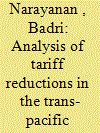

|
|
|
|
|
| Summary/Abstract |
Our purpose is to undertake a comparative analysis of the likely impact of tariff reduction under the Trans-Pacific Partnership (TPP) on various macro and trade variables of the Indian economy under different scenarios. The TPP was concluded in October 2015, but it is yet to be ratified by the partner countries, and while Asian giants like India, China and Korea have not joined the TPP, there are some talks about their joining the partnership in future. Ours is a unique study that evaluates India’s perspective on joining the TPP, in terms of tariff reduction, and not in terms of the removal of non-tariff barriers. We employ the widely used standard Global Trade Analysis Project (GTAP) model for this exercise. This is a unique framework with a global economy-wide approach, in a Computable General Equilibrium (CGE) setting. Five different scenarios of complete integration in terms of tariff reduction between different regions are simulated using the GTAP model. Under each scenario, the tariff among members of a group of regions is eliminated, but is unchanged for other regions. Higher welfare arising from allocative efficiency comes with the cost of a relatively lower consumption of domestic products and investment, resulting in a loss in terms of GDP. Therefore, we conclude that there are mixed prospects and no strong reason for India to pursue being part of the TPP in future, from a perspective of tariff reductions.
|
|
|
|
|
|
|
|
|
|
|
|
|
|
|
|
| 2 |
ID:
179713
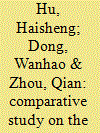

|
|
|
|
|
| Summary/Abstract |
This paper is a comparative study on the effects of a resource tax and a carbon tax. In this paper, we use the computable general equilibrium (CGE) approach to simulate the impact of China's increasing resource tax rate policy and carbon tax policy. The strengths and weaknesses of the two policies are compared from the perspective of energy utilization, air emissions, the macro economy, government tax revenue, household income, and enterprise net profit. A carbon tax leads to a reduction of all kinds of energy consumption. A carbon tax of 1 yuan/ton of CO2 can reduce CO2 emissions by 2100 tons and significantly reduce SO2, NOx, PM2.5, and PM10 emissions. From the perspective of energy utilization, carbon emissions, and pollutant emissions, the effect of a carbon tax is significantly better than that of a resource tax. If the rate of a resource tax rises by 50%, or a carbon tax is levied at the rate of 4 yuan/ton of CO2, China's economy (on a GDP basis) will decline by 0.1%.
|
|
|
|
|
|
|
|
|
|
|
|
|
|
|
|
| 3 |
ID:
136193


|
|
|
|
|
| Summary/Abstract |
We assess recent Chinese climate policy proposals in a multi-region, multi-sector computable general equilibrium model with a Chinese carbon emissions trading scheme (ETS). When the emissions intensity per GDP in 2020 is required to be 45% lower than in 2005, the model simulations indicate that the climate policy induced welfare loss in 2020, measured as the level of GDP and welfare in 2020 under climate policy relative to their level under business-as-usual (BAU) in the same year, is about 1%. The Chinese welfare loss in 2020 slightly increases in the Chinese rate of economic growth in 2020. When keeping the emissions target fixed at the 2020 level after 2020 in absolute terms, the welfare loss will reach about 2% in 2030. If China׳s annual economic growth rate is 0.5 percentage points higher (lower), the climate policy-induced welfare loss in 2030 will rise (decline) by about 0.5 percentage points. Full auctioning of carbon allowances results in very similar macroeconomic effects as free allocation, but full auctioning leads to higher reductions in output than free allocation for ETS sectors. Linking the Chinese to the European ETS and restricting the transfer volume to one third of the EU׳s reduction effort creates at best a small benefit for China, yet with smaller sectoral output reductions than auctioning. These results highlight the importance of designing the Chinese ETS wisely.
|
|
|
|
|
|
|
|
|
|
|
|
|
|
|
|
| 4 |
ID:
099254
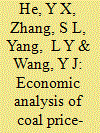

|
|
|
|
|
| Publication |
2010.
|
| Summary/Abstract |
In recent years, coal price has risen rapidly, which has also brought a sharp increase in the expenditures of thermal power plants in China. Meantime, the power production price and power retail price have not been adjusted accordingly and a large number of thermal power plants have incurred losses. The power industry is a key industry in the national economy. As such, a thorough analysis and evaluation of the economic influence of the electricity price should be conducted before electricity price adjustment is carried out. This paper analyses the influence of coal price adjustment on the electric power industry, and the influence of electricity price adjustment on the macroeconomy in China based on computable general equilibrium models. The conclusions are as follows: (1) a coal price increase causes a rise in the cost of the electric power industry, but the influence gradually descends with increase in coal price; and (2) an electricity price increase has an adverse influence on the total output, Gross Domestic Product (GDP), and the Consumer Price Index (CPI). Electricity price increases have a contractionary effect on economic development and, consequently, electricity price policy making must consequently consider all factors to minimize their adverse influence.
|
|
|
|
|
|
|
|
|
|
|
|
|
|
|
|
| 5 |
ID:
136192
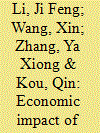

|
|
|
|
|
| Summary/Abstract |
We use a dynamic CGE model (SICGE) to assess the economic and climate impacts of emissions trading system (ETS) in China with a carbon price of 100 Yuan/ton CO2. A particular focus is given to the regulated electricity price regime, which is a major concern of electricity sector’s cost-effective participation in ETS in China. We found: (1) Carbon pricing is an effective policy for China to reduce CO2 emissions. Total CO2 emissions reduction ranges from 6.8% to 11.2% in short-term. (2) Rigid electricity price entails lower CO2 emissions reduction but can be considered as a feasible starting point to introduce carbon pricing policies in short-term as long as governmental subsidies are given to electricity production. (3) In mid- and long-term, the efficient policy is to earmark carbon revenue with competitive electricity price. We propose to use carbon revenue to reduce consumption tax in the first year of the introduction of carbon price and to use the carbon revenue to reduce production tax in following years.
|
|
|
|
|
|
|
|
|
|
|
|
|
|
|
|
| 6 |
ID:
067281
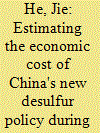

|
|
|
| 7 |
ID:
133886
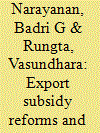

|
|
|
|
|
| Publication |
2014.
|
| Summary/Abstract |
The World Trade Organization (WTO) recommends all members to phase out their export subsidies. While this may render export-oriented industries susceptible to tighter competition in their import markets, productivity improvements could help offset such disadvantages. This article explores the interaction between these two different aspects to evaluate the economy-wide impact of export subsidy reforms and productivity improvements in the Indian textile and clothing sector. Our analysis stands on various policy simulations applying the general equilibrium model of the Global Trade Analysis Project (GTAP; Hertel, 1997). The welfare impacts of the removal of Indian textile and clothing subsidies in terms of equivalent variation shows that India is expected to encounter a loss of about 71.5 million US$, while other Asian countries may gain about 218 million US$. In a different scenario, we simulate the impact of a complete phase-out of subsidies provided to the textile and clothing industry of India and a simultaneous increase in total factor productivity growth to 3.5 per cent. This leads to a net positive welfare change and an expected gain of about US$ 13.17 million in terms of allocative efficiency. We conclude that merely removing subsidies is not enough, as is often argued by Indian policymakers that such a policy reversal might result in contraction of the sector. Investments in total factor productivity should come about simultaneously, probably by employing surplus funds from saved subsidy payments in areas like research and development and infrastructure. This conclusion may be qualitatively generalised for any sector in the world, which is examined for export subsidy reforms, but similar economy-wide studies are recommended for specific cases.
|
|
|
|
|
|
|
|
|
|
|
|
|
|
|
|
| 8 |
ID:
161775
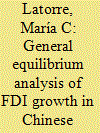

|
|
|
|
|
| Summary/Abstract |
This paper analyzes one of the features of the Chinese economic transition, namely, the impact of foreign direct investment (FDI) accruing to advanced services sectors. To that aim we use an innovative computable general equilibrium (CGE) model that includes, in a multi-regional setting, foreign multinationals operating in monopolistic competition. The model is based on data that split the world economy in 2016 into 11 regions (China - US - EU27 - Great Britain -other advanced economies - India - Japan - South East Asia - Latin America - Middle East - Sub Saharan Africa) and 21 sectors. We provide quantitative evidence on several characteristics of the 21 sectors in China, EU27 and the US, as well as other data on the role of China in the global stage, including its evolution since 2004. Several scenarios focusing on the increase of FDI inflows in services, because of the reduction of its FDI barriers, are simulated deriving short and long run results. We find that the impact of more foreign multinationals in services is positive for China but smaller than the one that had been obtained in other previous studies on FDI in manufactures. This is due to the still limited role of services in the Chinese economy and to a crowding out effect that domestic firms experience after the entry of foreign multinationals. On the whole the impact is, however, slightly positive for China, because manufactures benefit from the entry of foreign services multinationals. The rest of regions are unaffected or benefit very slightly, due to the fact that services production is less export oriented and more devoted to private consumption than in the case of manufactures. However, their manufacturing sectors are slightly harmed by the stronger Chinese competition. Many of them manage to more than offset this latter trend through higher exports or FDI in services directed to China.
|
|
|
|
|
|
|
|
|
|
|
|
|
|
|
|
| 9 |
ID:
110413
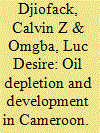

|
|
|
|
|
| Publication |
2011.
|
| Summary/Abstract |
This paper focuses on medium term policy options in the economic context of natural resource depletion. In particular, a novel approach for analyzing the impact of the permanent income hypothesis (PIH) with a dynamic recursive computable general equilibrium (CGE) model is employed. The model is benchmarked in an oil producing country with declining production, namely Cameroon. The results show that the PIH renders public finances less vulnerable during the post-oil transition. However, adopting the PIH is not associated with substantial improvements in growth and household welfare in Cameroon. Therefore, the PIH cannot be the only basis for better management of oil revenues in the country.
|
|
|
|
|
|
|
|
|
|
|
|
|
|
|
|
| 10 |
ID:
142016
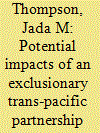

|
|
|
|
|
| Summary/Abstract |
The Trans-Pacific Partnership (TPP) is a free trade agreement that hopes to eliminate all tariff and non-tariff trade barriers between 12 participating countries. Japan, the fourth-largest trading partner for the United States, is a significant player in the negotiations. Due to cultural and historical significance it is expected that Japan will ask for exclusions on agricultural products, limiting the overall effectiveness of a fully liberalised agreement. Using a computable general equilibrium modelling framework across varying scenarios, we show the difference between the full liberalisation and potential exclusionary scenarios. Estimates show that a 25 per cent reduction in import tariffs on agricultural commodities in Japan results in a difference of net welfare benefits equal to –USD 7 billion, emphasising the importance of these concessions.
|
|
|
|
|
|
|
|
|
|
|
|
|
|
|
|
| 11 |
ID:
176887
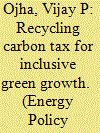

|
|
|
|
|
| Summary/Abstract |
In this decade, India has been pursuing a low carbon inclusive growth strategy. However, carbon tax, the most direct price instrument to reduce carbon emissions, has not found favour with policymakers because of its supposed detrimental effects on economic growth and income distribution. In the Indian context, the literature indicates that though carbon tax is extremely effective in abating carbon emissions, it simultaneously leads to reductions in GDP. There is, thus, an undesirable trade-off between economic growth and climate change mitigation. However, in trying to overcome this trade-off through a double-dividend from carbon tax, these studies have not really explored all possible options. Whether the carbon tax will yield a double-dividend or not, will depend upon how the carbon tax revenue is recycled.
|
|
|
|
|
|
|
|
|
|
|
|
|
|
|
|
| 12 |
ID:
139480
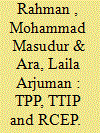

|
|
|
|
|
| Summary/Abstract |
The Transatlantic Trade and Investment Partnership (TTIP), the Trans-Pacific Partnership (TPP) and the Regional Comprehensive Economic Partnership (RCEP) could be the biggest trade deals in history. As the European Union (EU), the United States (US) and RCEP countries are the biggest trading partner of all South Asian countries, such preferential tariff arrangements could lead to a significant erosion of preferences enjoyed currently by the South Asian countries. Against this backdrop, the main objective of the present study is to investigate the potential economic impacts of tariff eliminations under TPP, TTIP and RCEP on South Asian countries using a standard computable general equilibrium model. The analysis evinces that under complete integration, in terms of tariff elimination, under these three mega deals, the excluded South Asian countries could face a tremendous negative impact on their economies. The analysis also suggests that South Asia may consider joining the TPP to minimize the negative economic impact due to arise from these mega deals.
|
|
|
|
|
|
|
|
|
|
|
|
|
|
|
|
| 13 |
ID:
147332
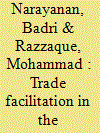

|
|
|
|
|
| Summary/Abstract |
This article examines the economic impact of trade facilitation between Commonwealth country members, using a global computable general equilibrium framework. We document enormous economic impact, much higher than a complete tariff liberalisation amongst these countries. The economic impact is quite visible in terms of welfare, gross domestic product, employment and trade in several sectors. We abstract from the costs involved in such trade facilitation—accounting for them is beyond the scope of this study.
|
|
|
|
|
|
|
|
|
|
|
|
|
|
|
|
| 14 |
ID:
093652
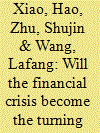

|
|
|
|
|
| Publication |
2009.
|
| Summary/Abstract |
Following the substantial damage from the financial crisis in 2008, can China's auto industry successfully take up new challenges and grasp the opportunities ahead? First and foremost, this paper summarises the ways that the financial crisis has impacted upon China's economy. By analysing the impacts based on the MCHUGE model, the paper concludes that reductions in export demand and consumption expectations have limited impact on China's auto industry, while the comparative reduction in investment expectations has a great impact on China's auto industry. The paper builds the MCHUGE model with imperfect competition in order to assess whether China's auto industry, characterised as an oligopoly, could successfully accept such a challenge. The conclusion of this paper indicates that the damage to China's auto industry caused by the financial crisis would appear even more serious if the static effect of an oligopoly was the only consideration. Finally, by simulating the implementation of the Revitalisation Plans of the Automobile Industry, it is concluded that the revitalisation policy aims to boost auto consumption and will thus bring new opportunities for China's auto industry; on the other hand, the mergers and acquisitions between and among auto industries, as well as the relevant potential technology progress and the popularisation of new energy automobiles, will further promote the development of China's auto industry.
|
|
|
|
|
|
|
|
|
|
|
|
|
|
|
|
|
|
|
|
|